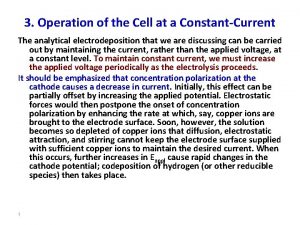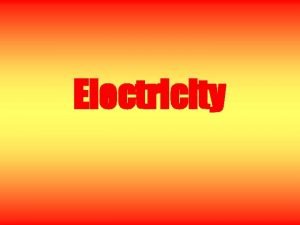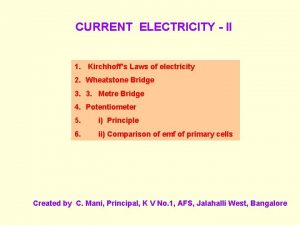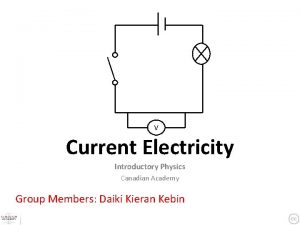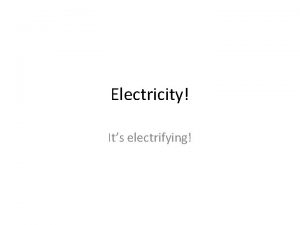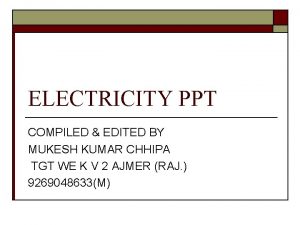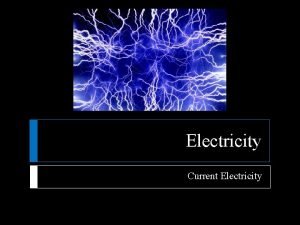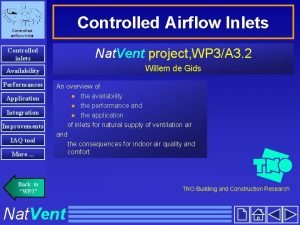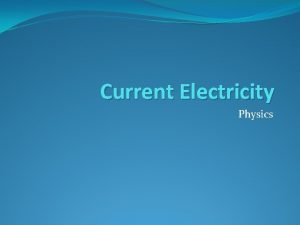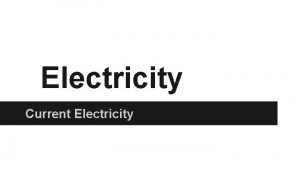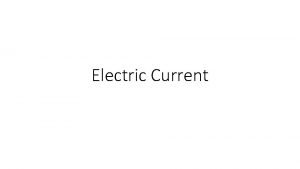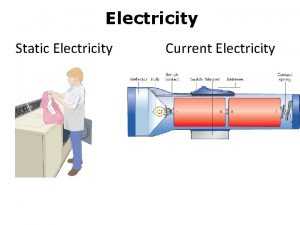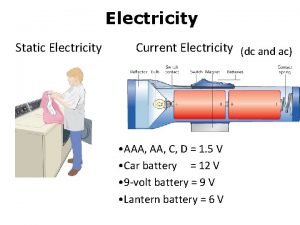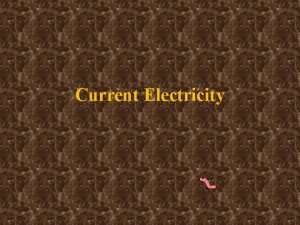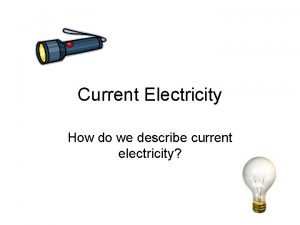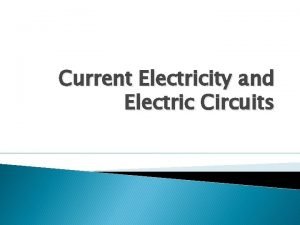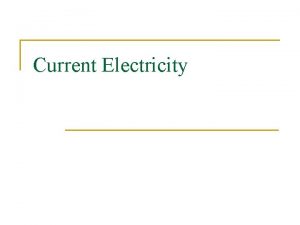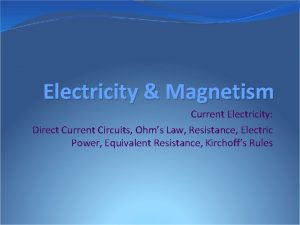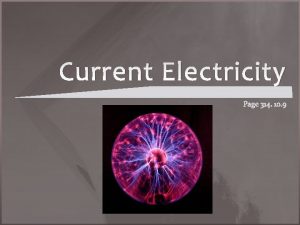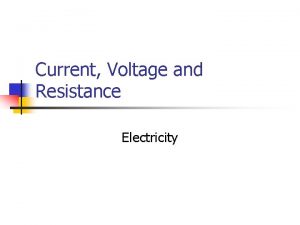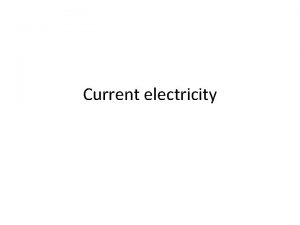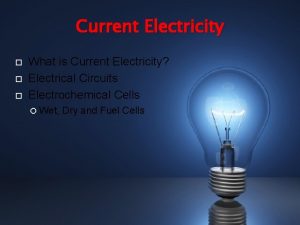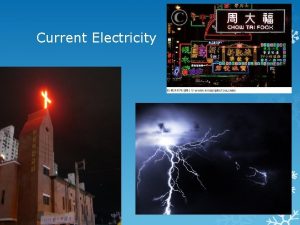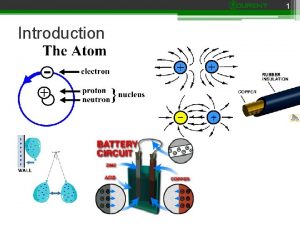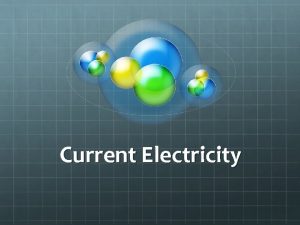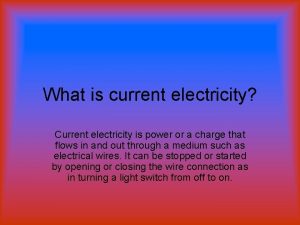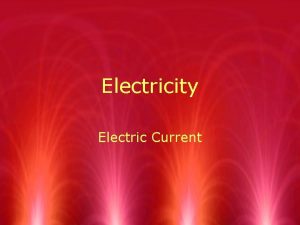Introducing Current Electricity Introducing Current Electricity the controlled




























- Slides: 28

Introducing Current Electricity

Introducing Current Electricity: the controlled flow of electrons through a conductor electron movement in an insulator electron movement in a conductor

Introducing Current Electricity Electric Circuit: a continuous path in which electrons flow

Introducing Current Electricity Electric Circuit: a continuous path in which electrons flow Source: a supplier of energized electrons -either a battery or from a wall outlet

Introducing Current Electricity Electric Circuit: a continuous path in which electrons flow Load: a device that converts electrical energy into other forms of energy -e. g. lamp or motor

Introducing Current Electricity Electric Circuit: a continuous path in which electrons flow Conductors: wires that transmit electrons from the source anode (negative terminal) to the load & back to the source cathode (positive terminal)

Introducing Current Electricity Electric Circuit: a continuous path in which electrons flow Switch: a device that controls the flow of electrons by opening the circuit open closed

Introducing Current Electricity Electrical Energy: the energy provided by the flow of electrons in an electric circuit

Introducing Current Electricity Electrical Energy: the energy provided by the flow of electrons in an electric circuit Electric Cell: a device that converts chemical energy into electrical energy Batteries: can contain one or many cells

Introducing Current Electricity Electrical Energy: the energy provided by the flow of electrons in an electric circuit Electric Cell: a device that converts chemical energy into electrical energy Batteries: can contain one or many cells Primary Cell: an electric cell that can be used only once Secondary Cell: an electric cell that can be recharged

Introducing Current Electricity Electrical Energy: the energy provided by the flow of electrons in an electric circuit Electric Cell: a device that converts chemical energy into electrical energy Batteries: can contain one or many cells Primary Cell: an electric cell that can be used only once Secondary Cell: an electric cell that can be recharged Fuel Cell: a special kind of electric cell through which a continuous supply of chemicals is pumped as the cell operates

Introducing Current Electricity Forms of Current Electricity Direct Current: a flow of electrons in one direction through an electric circuit -form produced by batteries

Introducing Current Electricity Forms of Current Electricity Alternating Current: a flow of electrons that alternates in direction in an electric circuit -produced in generating stations because it's more efficient at distributing electricity long distances

Electricity and Voltage - Electricity is the flow of electrons (-) Charges (-) flow from HIGH voltage areas to LOW voltage areas – Voltage is like electrical pressure that pushes and pulls charges – Voltage Difference: the push/pull that causes charges to move and is measured in volts (V)

Voltage • Voltage is created by – a chemical cell (battery) when it changes chemical energy to electrical energy – by a generator when it changes mechanical energy to electrical energy – by a solar cell when it changes light energy to electrical energy.

Voltage and Current • When a wire connects the terminals of a battery or generators, then the voltage will push and pull electrons through a conductor. – One terminal has extra electrons thus a negative charge. The other terminal has a deficit of electrons and thus a positive charge. – Electrons in the wire are pushed by the negative terminal and pulled by the positive terminal through the wire Circuit: a closed, conducting path • For changes to flow, the wire must always be connected in a circuit • Electric Current: the flow of charges through a wire or any conductor. Measured in Amperes (A=Amps) • Current is almost always the flow of electrons • What happens if we break the circuit?

Check for Understanding • What is voltage? • How is voltage generated? (3 ways) • What is current?

Resistance • Resistance: the tendency for a material to oppose the flow of electrons • Changes electrical energy into thermal energy and light • Ex: lightbulb filament • Resistance is measured in Ohms (Ω)

What Affects Resistance?

IV. Control the Flow • A voltage difference causes the charges to flow • Flow of charges= current (Amps or A) • Electrical resistance restricts the movement of charges Resistance = current Pressure = current (Voltage Difference)

Ohm’s Law Current = voltage difference Resistance I = V/R or V=IR I= current (units = A, amps) V= voltage (units = V, volts) R = resistance (units = ohms Ω) Tutorial

Section 3 – Electrical Energy I. Series Circuit: the current has only one loop to flow through – – – things are wired one right after the other If one thing (bulb) goes out every thing goes out If the circuit is broken the entire flow of current stops

Series Circuit • Current is the same at each point in the circuit • When another resistor (light bulb) is added in series, the total resistance increases. • When resistance increases, current will decrease. • Decreased current means dimmer light.

II. Parallel Circuit: contains two or more branches for current to move through – – – current splits up to flow through the different branches because all branches connect the same two points of the circuit – the voltage difference is the same in each branch more current flows through the branches that have the lower resistance

Household Electrical Safety • In a house, many appliances draw current from the same circuit – If more appliances are connected to a circuit, more current will flow through the wires – More current in wires = more heating in the wires – More heat causes insulation on wires to melt, which increases chances of fire • To protect a house from this, all household circuits have a: 1. Fuse, or 2. Circuit breaker

Household Circuits: Fuse: a small piece of metal that melts if the current becomes too high Circuit Breaker: contains a small piece of metal that bends when it gets hot bending causes a switch to flip and opens the circuit

Let’s Compare Series and Parallel Circuits Series Circuits Parallel Circuits • _______ path(s) for current • Current ________________ • Voltage ________________ • Break in circuit _______________________ • Adding resistance in series ___________ • Adding resistance in parallel ____________

Let’s Compare Series and Parallel Circuits Series Circuits Parallel Circuits • 1 path(s) for current • multiple path(s) for current • Current is the same at every point • Current can be different in each branch • Voltage drops at each resistor • Voltage same across each resistance • Break in circuit stops all current • Break in circuit does not affect other bulbs • Adding resistance in series decreases total current (dimmer light bulbs) • Adding resistance in parallel increases total current
 Current electricity gif
Current electricity gif Electricity and magnetism vocabulary
Electricity and magnetism vocabulary Static electricity and current electricity
Static electricity and current electricity Coulometric method of analysis
Coulometric method of analysis Venn diagram of series and parallel circuit
Venn diagram of series and parallel circuit What is electrical
What is electrical Current electricity
Current electricity Difference between static and current electricity
Difference between static and current electricity What is current electricity in physics
What is current electricity in physics Current electricity def
Current electricity def Current electricity ppt
Current electricity ppt Bill nye electricity worksheet
Bill nye electricity worksheet Touch current vs leakage current
Touch current vs leakage current Drift current
Drift current Infineon
Infineon A balanced delta connected load having an impedance 20-j15
A balanced delta connected load having an impedance 20-j15 Mesh current method with current source
Mesh current method with current source Ceramic composition resistors
Ceramic composition resistors Drift current density unit
Drift current density unit Line vs phase voltage
Line vs phase voltage At cut off the jfet channel is
At cut off the jfet channel is In alternators the welding current is produced on the
In alternators the welding current is produced on the Ac theory 3 lesson 4
Ac theory 3 lesson 4 Energy band diagram of pn junction diode
Energy band diagram of pn junction diode Balanced delta-delta connection
Balanced delta-delta connection Các châu lục và đại dương trên thế giới
Các châu lục và đại dương trên thế giới Thế nào là hệ số cao nhất
Thế nào là hệ số cao nhất Sơ đồ cơ thể người
Sơ đồ cơ thể người Tư thế ngồi viết
Tư thế ngồi viết



